History
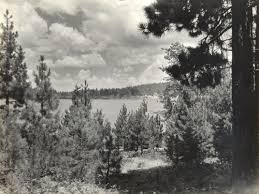 In 1826, the first white man to set foot in Little Bear Valley (now known as Lake Arrowhead) was a fur trader, who was a partner of Jedediah Smith.
In 1826, the first white man to set foot in Little Bear Valley (now known as Lake Arrowhead) was a fur trader, who was a partner of Jedediah Smith.
At that time, about 40 Paiute Indians, a warlike tribe, used the mountains for their hunting grounds. They lived in the high desert area. Many of these Indians were killed in a fight with the white men of Little Bear Valley, as a result of the Indians setting fire to one of the cabins in the Valley.


At the same time, a more peaceful tribe of Indians, the Serranos, lived near Little Bear Valley, in an area now known as Rock Camp on the North side of the mountain. They did not bother the settlers until one of the white men made advances to an Indian maiden, which caused a skirmish killing both Indians and white men.
 Later in the 1860′s, the main attraction for the white man at Little Bear Valley was logging, lumber, and cattle, and there were several saw mills in and around the Valley. The first so-called “Mormon Road” up the mountain was built in 1852. The “Daley Canyon Road” was built in 1870. Summers were productive in the Valley, but everything stopped in the Winter.
Later in the 1860′s, the main attraction for the white man at Little Bear Valley was logging, lumber, and cattle, and there were several saw mills in and around the Valley. The first so-called “Mormon Road” up the mountain was built in 1852. The “Daley Canyon Road” was built in 1870. Summers were productive in the Valley, but everything stopped in the Winter.
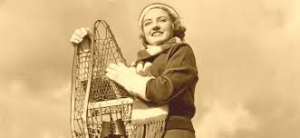 A few families remained during the Winter months and the only diversion was to snowshoe to their neighbors (usually miles away) to visit.
A few families remained during the Winter months and the only diversion was to snowshoe to their neighbors (usually miles away) to visit.
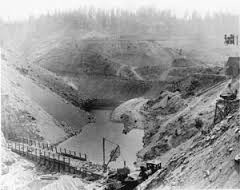 In 1891, three Ohio businessmen chose Little Bear Valley as a likely spot for a reservoir, to supply water to the southern lowlands. Land was purchased and water rights were obtained.
In 1891, three Ohio businessmen chose Little Bear Valley as a likely spot for a reservoir, to supply water to the southern lowlands. Land was purchased and water rights were obtained.
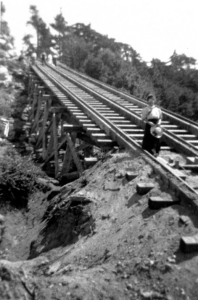 The Arrowhead Reservoir Company was formed. In 1890, a tramway, (a cable powered device) was built from Waterman Canyon up the mountain for the purpose of transporting supplies for the building of the dam. However, engineering problems rendered it unsuccessful. Consequently, supplies and machinery were transported via the switch-back road. Construction of the dam for the reservoir started in 1893. Camp I on the North slope of the Valley served as living quarters and mess hall for the workers.
The Arrowhead Reservoir Company was formed. In 1890, a tramway, (a cable powered device) was built from Waterman Canyon up the mountain for the purpose of transporting supplies for the building of the dam. However, engineering problems rendered it unsuccessful. Consequently, supplies and machinery were transported via the switch-back road. Construction of the dam for the reservoir started in 1893. Camp I on the North slope of the Valley served as living quarters and mess hall for the workers.
In 1905, the property was transferred to a new corporation, Arrowhead Reservoir and Power Company, because the idea of utilizing the water for power had been conceived. The dam is what is known as a semi-hydraulic fill dam. It is 200 feet high, 720 feet long, and 1,100 feet thick at the base. It has a steel reinforced concrete core wall embedded 20 feet in bed rock. The trees and brush were removed from what was the bottom of the lake, so the decay would not be a problem. The lake filled slowly from runoff.
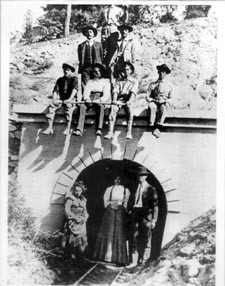 By 1912, the dam was 80% complete, and work continued for several years after that. The plans called for over 60 miles of water conveyances and tunnels. However, only 6 1/2 miles were completed, when it became known that the State ruled in favor of the ranchers on the upper desert side of the Northward facing watershed, and passed laws which prevented the diverting of water from its natural watersheds for other than domestic use. Thus the company was stopped with continuing its plan to transport water to the areas south of the mountains, and even though the lake was filling with water, the project was abandoned.
By 1912, the dam was 80% complete, and work continued for several years after that. The plans called for over 60 miles of water conveyances and tunnels. However, only 6 1/2 miles were completed, when it became known that the State ruled in favor of the ranchers on the upper desert side of the Northward facing watershed, and passed laws which prevented the diverting of water from its natural watersheds for other than domestic use. Thus the company was stopped with continuing its plan to transport water to the areas south of the mountains, and even though the lake was filling with water, the project was abandoned.
The Arrowhead Lake Company, a Los Angeles syndicate, bought Little Bear Valley and surrounding land (deriving the name from a natural formation in the form of an arrowhead on the face of the San Bernardino Mountain, near Arrowhead Hot Springs, which is rooted in Indian legend).
 The Arrowhead Lake Company’s plan was to develop the mile high man-made lake into a fine recreation and residential area. Between 1921 and 1923, the dam was completed (31 feet higher than originally planned) and a road was constructed partially around the North shore of the lake. The Norman styled village which included a dance pavilion, outdoor movie theater, restaurant, beach and bath houses was completed. Three hotels were built; the Arlington Lodge, Village Inn, and North Shore Tavern. A 9-hole golf course was built on the site of the present golf course. Some of the lake side land was subdivided and was sold for private homes and secluded north shore estates.
The Arrowhead Lake Company’s plan was to develop the mile high man-made lake into a fine recreation and residential area. Between 1921 and 1923, the dam was completed (31 feet higher than originally planned) and a road was constructed partially around the North shore of the lake. The Norman styled village which included a dance pavilion, outdoor movie theater, restaurant, beach and bath houses was completed. Three hotels were built; the Arlington Lodge, Village Inn, and North Shore Tavern. A 9-hole golf course was built on the site of the present golf course. Some of the lake side land was subdivided and was sold for private homes and secluded north shore estates.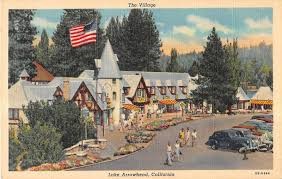
Many Hollywood stars, like Clark Gable stayed at the hotel during the era, and some purchased homes in the resort. The studios frequently used the area for making movies like the classic Heidi starring Shirley Temple filmed near Switzer Park, or Now Voyager starring Bette Davis filmed at the UCLA Conference Center.
A domestic water system, pumping water from deep in the lake, supplied water to homes and structures. Strict conditions affecting the use of land and building Arrowhead Woods were recorded with each tract, including the removal of trees.
During the World War II years, Lake Arrowhead Village was a popular rest and recuperation area for service men. Because of gas rationing, tourists were scarce.
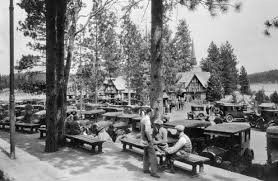 In spite of the lot sales, financial troubles developed and Arrowhead Lake Company went into receivership. In 1946, the Los Angeles Turf Club (owners of Santa Anita Race Track) purchased the lake and surrounding properties, known as Arrowhead Woods. Several million dollars were spent by the Turf Club, within the first few years of their ownership, improving the properties. No lots to speak of were sold during the Turf Club ownership. However, they made several donations of land to various organizations, such as the Boy Scouts, Girl Scouts, San Bernardino County, churches, and Sister of St. Joseph of Orange (the builders of the hospital). They also donated $50,000 for the construction of the hospital. The famous North Shore Tavern was donated to the University of California and is now a popular conference center.
In spite of the lot sales, financial troubles developed and Arrowhead Lake Company went into receivership. In 1946, the Los Angeles Turf Club (owners of Santa Anita Race Track) purchased the lake and surrounding properties, known as Arrowhead Woods. Several million dollars were spent by the Turf Club, within the first few years of their ownership, improving the properties. No lots to speak of were sold during the Turf Club ownership. However, they made several donations of land to various organizations, such as the Boy Scouts, Girl Scouts, San Bernardino County, churches, and Sister of St. Joseph of Orange (the builders of the hospital). They also donated $50,000 for the construction of the hospital. The famous North Shore Tavern was donated to the University of California and is now a popular conference center.
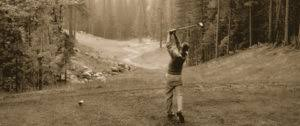 In 1960, three businessmen/developers from Los Angeles bought Lake Arrowhead and formed the Lake Arrowhead Development Company. They built the present 18-hole golf course. Eighteen residential tracts were subdivided, also with strict deed restrictions, and included in Arrowhead Woods.
In 1960, three businessmen/developers from Los Angeles bought Lake Arrowhead and formed the Lake Arrowhead Development Company. They built the present 18-hole golf course. Eighteen residential tracts were subdivided, also with strict deed restrictions, and included in Arrowhead Woods.
A water filtration plant was built to filter domestic water supplied to the Arrowhead Woods residences.
In 1967, Lake Arrowhead Development Company merged with Boise Cascade Corporation of Boise, Idaho. Boise continued the subdivision of properties and developed five additional residential tracts.
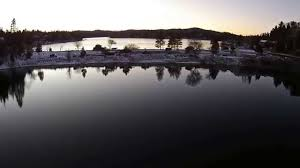 In 1971, Lake Arrowhead was purchased by seven businessmen from Chicago. In 1973, Boise Cascade was forced to reacquire Lake Arrowhead through foreclosure. This Chicago group retained some of the properties not mortgaged by Boise, including some unsub divided acreage. At the time Boise reacquired the property, they were faced with the problem of building a new dam or lowering the lake 70 feet, due to a study required by the State to be made of all dams in California following the Van Norman Dam incident in the 1971 Sylmar Earthquake. The study found the Arrowhead dam would probably be unsafe if an earthquake of 6.5 magnitude were to occur in this area.
In 1971, Lake Arrowhead was purchased by seven businessmen from Chicago. In 1973, Boise Cascade was forced to reacquire Lake Arrowhead through foreclosure. This Chicago group retained some of the properties not mortgaged by Boise, including some unsub divided acreage. At the time Boise reacquired the property, they were faced with the problem of building a new dam or lowering the lake 70 feet, due to a study required by the State to be made of all dams in California following the Van Norman Dam incident in the 1971 Sylmar Earthquake. The study found the Arrowhead dam would probably be unsafe if an earthquake of 6.5 magnitude were to occur in this area.
However, Boise felt that the building of a dam should be shared by all property owners in Arrowhead Woods, and legislation was passed to permit a bond issue to be voted on by property owners to finance the building of a new dam downstream. A bond for seven million dollars was passed in 1974 and an earth fill dam was built. A small lake was formed between the two dams, named by a local resident, Papoose Lake.
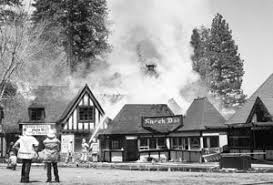 The property owners in Arrowhead Woods bought Lake Arrowhead in October 1975 from Boise, and Boise sold their remaining holdings in Lake Arrowhead to Metropolitan Advertising Agency in 1977. In 1978, a group of investors, headed by developer, George Coult, bought the Village and Lodge properties, and in April 1979, a “Burn to Learn” exercise was conducted by the Lake Arrowhead Fire Protection District, with the San Bernardino County fire departments and Air Corps taking part. All structures in the Village were burned down except the original dance pavilion building, the post office and real estate office.
The property owners in Arrowhead Woods bought Lake Arrowhead in October 1975 from Boise, and Boise sold their remaining holdings in Lake Arrowhead to Metropolitan Advertising Agency in 1977. In 1978, a group of investors, headed by developer, George Coult, bought the Village and Lodge properties, and in April 1979, a “Burn to Learn” exercise was conducted by the Lake Arrowhead Fire Protection District, with the San Bernardino County fire departments and Air Corps taking part. All structures in the Village were burned down except the original dance pavilion building, the post office and real estate office.
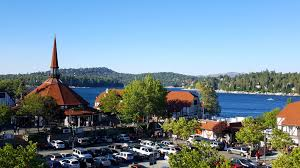 The beautiful new Village was built in much the same architecture as the old Village, and the dance pavilion was restored as the theme building, which now houses businesses. The Village includes a complete convenience shopping center, restaurants, boutiques, gift shops, specialty stores, factory outlets and lake tours on a 60-seat capacity paddle wheel.
The beautiful new Village was built in much the same architecture as the old Village, and the dance pavilion was restored as the theme building, which now houses businesses. The Village includes a complete convenience shopping center, restaurants, boutiques, gift shops, specialty stores, factory outlets and lake tours on a 60-seat capacity paddle wheel.
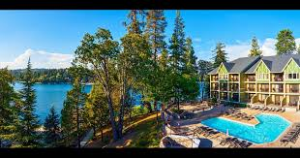 The spectacular Arrowhead Hilton Lodge, now the Lake Arrowhead Resort and Spa, was built on the site of the original Arlington Lodge and opened in November of 1982.
The spectacular Arrowhead Hilton Lodge, now the Lake Arrowhead Resort and Spa, was built on the site of the original Arlington Lodge and opened in November of 1982.
Today, Lake Arrowhead is not only a popular recreational area for visitors, it is also a beautiful year-round alpine residential community at 5100 feet elevation.
For more information on our history please visit the Rim of the World History Society website.
